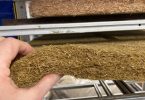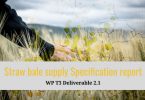EN: This thesis analyses methods of building with straw bales with regard to their thermal insulation characteristics, using the technique of thermography. Internal and external thermographic measurements were therefore taken for nine straw bale houses located in northern and eastern Germany, built using different building techniques. The main focus was on wall design as well as on specific details of construction.
Within the framework of this thesis, an analysis was conducted to ascertain whether thermal bridges are created during the construction of straw bale houses that do not derive as a result of using straw as an insulation material but rather that depend on the processing techniques used when compressing or stuffing the straw bale walls and sealing them against the ingress of air and moisture. In addition, further testing was undergone to examine whether there are potential thermal bridges that have not occurred under laboratory conditions or that have been neglected in prior theoretical examinations.
With the help of thermography, it was demonstrated that all the wall designs of the straw bale houses studied exhibited very good thermal insulation characteristics. Those constructions with posts on the insides of the straw bale walls and the load-bearing construction showed a slightly more homogeneous temperature distribution than the timber frame construction and the I-beam construction. In addition, the thermograms showed that for thermal insulation purposes the existing, relatively time consuming efforts to compress, stuff and seal the walls against the ingress of air or moisture are justified. Critical thermal bridges, which only occurred in exceptional cases, are likely to derive from processing defects that occur when sealing against the ingress of air. Provided that the sealing process is carried out correctly, timber that passes from the inside to the outside of a wall does not tend to exhibit critical thermal bridges. Problems concerning moisture were not discovered in any of the straw bale houses studied.
DE: Die vorliegende Arbeit untersucht die Konstruktionsweisen im Strohballenbau hinsichtlich ihres Wärmedämmverhaltens mit Hilfe der Thermografie. Dazu wurden Innen- und Außenthermografiemessungen von neun Strohballenhäusern unterschiedlicher Bauweisen in Nord- und Ostdeutschland gemacht. Die Schwerpunkte wurden hierbei auf die Wandkonstruktionen einerseitsund auf ausgewählte Konstruktionsdetails andererseits gelegt. Im Rahmen dieser Arbeit wurde untersucht, ob beim Bau von Strohballenhäusern Wärmebrücken entstehen, die nicht allein auf den Dämmstoff Stroh zurückzuführen sind, sondern die von der Art der Ausführung beim Komprimieren, beim Stopfen, bei der Luftdichtung oder beim Feuchteschutz abhängig sind. Darüber hinaus wurde überprüft, ob es potentielle Wärmebrücken gibt, die unter Laborbedingungen nicht auftraten oder die bei den bisherigen theoretischen Überlegungen vernachlässigt wurden.
Mit Hilfe der Thermografie konnte gezeigt werden, dass alle untersuchten Wandkonstruktionen von Strohballenhäusern sehr gute Wärmedämmeigenschaften aufweisen. Die Konstruktionen mit innen stehenden Holzständern und die lasttragende Bauweise zeigen dabei etwas homogenere Temperaturverteilungen als die Bohlenständerbauweise und die TJI-Trägerkonstruktion. Die Thermogramme zeigen ebenfalls, dass die bisherigen – relativ aufwendigen – Bemühungen bei der Luftdichtung sowie beim Komprimieren und Stopfen von Strohballenwänden aus wärmedämm-technischer Sicht gerechtfertigt sind. Kritische Wärmebrücken, die nur in Ausnahmefällen auftraten, sind vermutlich auf Verarbeitungsfehler bei der Luftdichtung zurückzuführen. Von innen nach außen durchgehende Holzbalken stellen – bei korrekter Luftdichtung – in der Regel keine kritischen Wärmebrücken dar. Probleme mit Feuchtigkeit konnten bei keinem der untersuchten Strohballenhäuser festgestellt werden.
Author: Hemke, Ole





